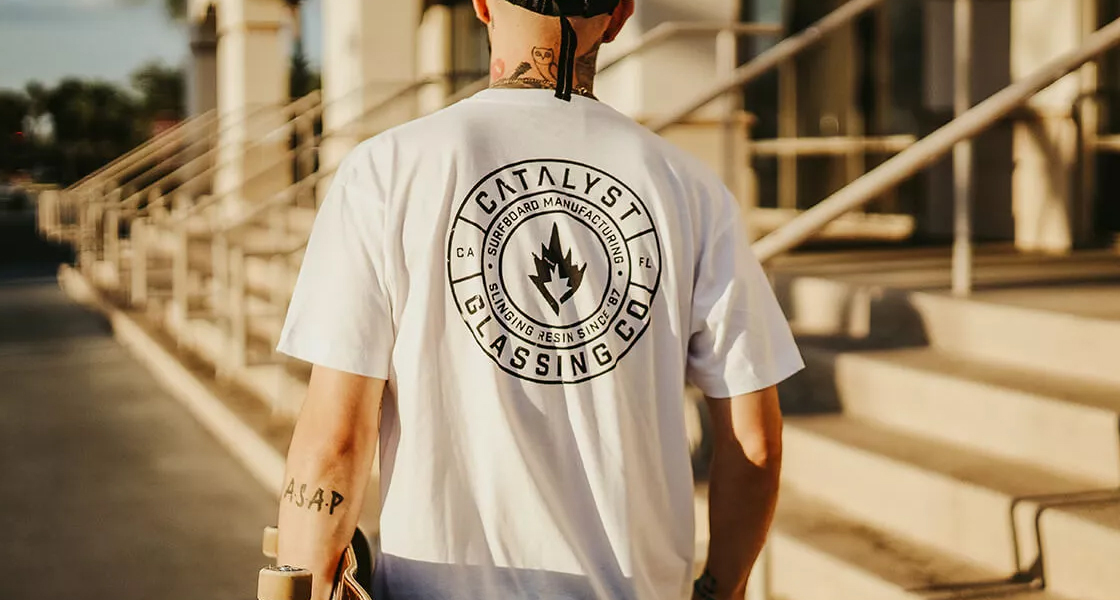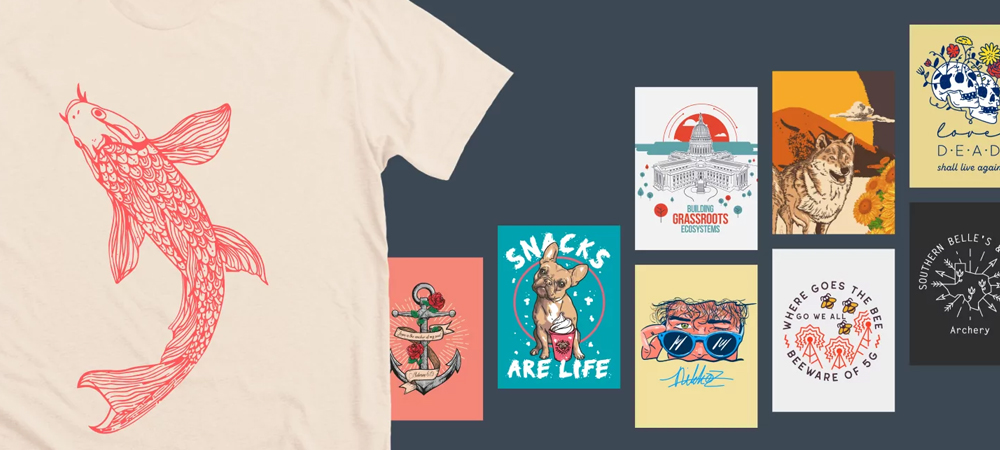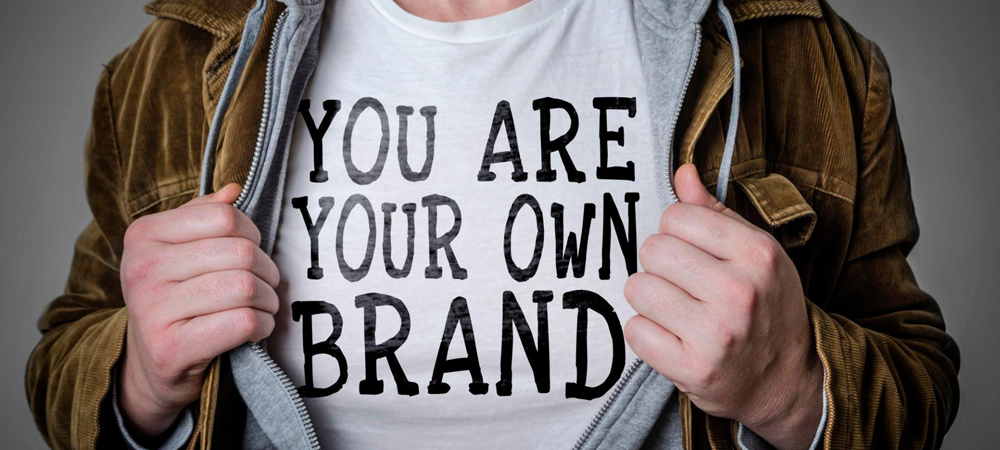
Neel Patel November 17, 2023
12 Essential T-Shirt Design Tips for Your Print-on-Demand Business
Selling t-shirts online can be an exciting adventure, whether you’re doing it for fun or aiming for a fully developed business. Whether creating t-shirts for a special event or trying to build your brand, these t-shirt design tips are relevant for everyone.
No matter why you’re selling t-shirts, the goal is the same: you want your designs to make people feel good and want to wear them again and again. So, the first step is to come up with fantastic t-shirt design ideas that resonate with your target audience.
But here’s the challenge: how can you turn these ideas into actual t-shirts without spending a fortune upfront? That’s where the print-on-demand business model comes in. With print-on-demand, you have the freedom to create as many designs and product mockups as you want, and you can showcase them in your online store without any initial costs. You only pay when a customer places an order. This means you can experiment with various designs and focus on marketing your unique custom t-shirts.
In this article, we’re going to learn about the common mistakes to avoid in t-shirt design and share the best tips to make your t-shirt designs go from ordinary to extraordinary.
1. Research t-shirt designs

One of the most common errors people make when designing t-shirts (or any other product, really) is rushing into it without proper preparation. Before you dive into creating your t-shirt designs, it’s crucial to do some market research.
To make things easier for you, we’ve put together a list of helpful questions that can guide your creative thinking and lead to fantastic designs. So, let’s start by asking the right questions and crafting those superb t-shirt designs!
Why do you want to design t-shirts? What is your cause?

Think about why you’re doing this. Are you trying to spread the word about autism or mental health? Maybe you’re a big sports fan and want to sell t-shirts to fellow sports lovers. Or it could be that you dream of starting your own clothing brand.
No matter what you’re up to, it’s essential to be clear about your purpose. Whether you’re creating shirts for your company, designing tank tops for surfers, or anything else, your intentions matter. Make sure your design choices match the message you want to convey.
What emotions do you want your t-shirt design to evoke?

In general, your t-shirt design should make people feel good. You want them to experience positive emotions like love, unity, pride, confidence, empowerment, inspiration, excitement, or relaxation when they see your design. You can also choose to go for humor by using sarcasm or irony. Another option is to tap into feelings of nostalgia with vintage t-shirt designs.
The emotion you aim to evoke will shape your t-shirt design. For example, if you want to convey excitement or empowerment, bold fonts and vibrant graphics work well. On the other hand, if you’re aiming for a relaxed and tranquil vibe, you might opt for pastel colors and nature-themed elements. We’ll explore fonts, graphics, and colors in more detail shortly.
Who would wear your t-shirt designs?

Think about the people you want to sell your t-shirts to and what kind of designs they’d proudly wear. Are you making shirts for a company, or do you want to make a statement with your designs? Maybe you’re targeting pun enthusiasts. To get the right insights, do some research. You can use handy tools like Google Trends and Statista.
Perhaps you’re considering going for classic retro t-shirt designs that lots of people would like, or maybe you want to focus on a specific group, like fans of George Orwell. These are some good starting points when you’re working with print-on-demand niches.
When would people wear your custom t-shirts?

When you’re creating your custom t-shirts, think about where your potential customers might want to wear them comfortably. Will they put them on for a birthday party, a professional networking event, during a vacation, a cozy family dinner, or just while running errands around town?
You don’t have to cover all these situations, but the more you can cater to, the better your chances of selling your t-shirt design.
Now that you’ve put in some quality brainstorming time, let’s move on to the best tips for making your t-shirt designs a success.
2. Use high-quality graphics

Imagine this: you decide to use a low-quality image for your t-shirt design. What’s the result? You’ll get a print that looks cheap and not very attractive unless you intentionally want a roughed-up, distressed look.
To ensure your t-shirt designs come out looking sharp and appealing, it’s essential to use high-quality graphics. Before you go ahead and bring your t-shirt design to life, take a look at the Optamark print guidelines. They’ll give you the scoop on things like image resolution, file size, and type, which are all super important to get that perfect print your customers will love.
Let’s talk about the technical stuff for your t-shirt designs. To make sure everything turns out great, you need to pay attention to a few key details:
- File Formats: You should use PNG or JPEG files for printing and for embroidery, PDF or PNG. While JPEG is okay, it’s not the best choice for embroidery because it often comes with a background that can make your design look not-so-great. Plus, it can increase the stitch count, which might be a problem.
- Print Area Size: If you’re going for embroidery, the main area on t-shirts is about 10 inches by 16 inches. For designs printed directly onto the fabric (DTG), the front area varies from 10 inches by 12 inches to 12 inches by 16 inches.
- Resolution (DPI): The resolution of your print file should be at least 150 DPI (dots per inch), but it shouldn’t go higher than 300 DPI. Going beyond 300 won’t make your design look better; it’ll just make the file bigger.
- Color Profile: Make sure your final design is saved with the sRGB color profile called “sRGB IEC61966-2.1.” You can set this in your image editing software.
- Content Guidelines: Your design needs to follow the content guidelines. This means it can’t promote hate, break any laws, or violate someone else’s intellectual property rights. If it does, it might not get approved.
- Pro Tip: If you want your t-shirt design to look good no matter the size, use vector graphics. You can find a bunch of vector images from our partner to get your creative juices flowing.
These details might sound technical, but they’re essential to ensure your t-shirt designs come out just the way you want them to!
3. Design for the garment
When you’re turning your t-shirt design idea into reality, think about whether someone would actually want to wear it. Not all designs that look great on a mug or a phone case will work well on a t-shirt.
T-shirt designs have their own set of rules. They should be eye-catching and easy to understand without feeling overly promotional. Remember, you’re not designing a big billboard.
A helpful tip is to get rid of the background in your design. If you simply slap an image onto a t-shirt, it can end up looking like a huge sticker. You can easily remove the background using graphic design software like Photoshop, Adobe Illustrator, Canva, or Inkscape, or you can use our background removal tool. Save your file as a transparent PNG for the best results.
To get a real feel for how your t-shirt design will look, print it out at its actual size and place it on a t-shirt you have or even better, have someone model it for you. This simple trick can help you spot any areas that need improvement and make sure your final t-shirt design looks just right.
4. Focus on typography
When you add text to your custom t-shirt design, it’s important that people can easily read it. Experiment with different font styles and choose ones that match the theme of your design. Your font choice sends a message to your audience, so pick wisely.
Over the years, we’ve all come to associate different fonts with certain qualities, thanks to advertisements, logos, and graphic designs. That’s why selecting the right font for your theme is really important for creating a fantastic t-shirt design. For instance, academic fonts like Times New Roman, Helvetica, or Arial go well with graduation or philosophical t-shirt designs.
If you’re going for a playful vibe, fonts like Aloja or Nafta are great for kids’ t-shirts or lighthearted themes. But if you want a classic, timeless design, stick with simple fonts like Graduate or Special Elite. And if you need more font inspiration, check out our list of the best t-shirt fonts.
Don’t forget to pay attention to the spacing between letters and lines. This ensures that your text looks good and is easy to read, even from a distance. To get it just right, follow some general guidelines, and you’ll be on your way to creating text that captures attention on your t-shirt design.
- When it comes to letter spacing, you can make things easier by using “optical kerning” or the “auto” kerning option in your design software. These features automatically adjust the space between letters for a balanced look.
- As for line spacing, it depends on the size of your font. A good rule of thumb is to set it at around 120–130% of the font size. For example, if your font is 12 points, your line spacing should be around 14–15 points.
- To make sure your words and graphics work together seamlessly, create a mockup of the t-shirt. This lets you see how everything will look in real life and make any necessary adjustments for a well-balanced design.
To make your text look good and easy to read, here are some simple tips for typography and fonts:
- Highlight the Important Words: Make the most important words stand out by making them bold and placing them near the top of your design.
- Be Cautious with Textures and Shadows: Use textures and drop shadows sparingly, or sometimes it’s best to avoid them altogether.
- Font Variety: It’s okay to use fonts with different styles to make your design more interesting, but try not to use more than three font types.
- Avoid Huge Block Letters: Large block lettering is better suited for advertisements, so keep it in check for your t-shirt designs.
- Let Your Main Hero Shine: Ensure that your main message or design element stands out and doesn’t get overshadowed by other design elements.
- Clear Backgrounds: Avoid putting text on busy images, as it can make it hard to read.
- Mind the Line Breaks: Remember that how you break lines of text can affect how your message is read and understood.
Now that we’ve covered typography and fonts, let’s explore the wonderful world of colors!
5. Be careful with colors and contrast
If you’re new to graphic design, it’s important to understand the basics of color psychology and how color theory works. Research shows that 92.6% of customers really care about how things look when they’re shopping online, especially in ecommerce where visuals are a big deal.
Each color can make people feel different things, so choose colors that match the message you want to send. Think about whether your colors make your product feel fancy or budget-friendly, calm or action-oriented.
Also, consider how the colors in your design go together and how they look on the t-shirt color you’re using.
Lastly, remember that more contrast makes your design stand out more, while less contrast makes it more subtle. Light colors work well on dark backgrounds, and dark colors work well on light backgrounds. For the most eye-catching look, think about using black on white or white on black.
6. Don’t copy anyone
Creating unique t-shirt designs is not just about avoiding legal issues like copyright infringement (you can learn more about copyrights and trademarks in printing). It’s also about offering something special that people genuinely appreciate.
When you copy trending t-shirt designs, you’re essentially entering a crowded market where established designers already rule. Why would someone choose your almost identical design when others have more reviews and sales?
Instead, you can follow the same theme as trending t-shirt designs but add your unique twist. To stay in the fashion game, keep an eye on the latest trends and try to hop on new trends early. For inspiration, check out these best-selling t-shirt designs, and learn from what works and what doesn’t.
7. Find the best design placement
When printing t-shirts, where you put your design really matters. You can choose the front, back, or sleeve. But before deciding, think about your audience, your creative vision, and your budget. Be aware, though, that adding a design to the back or sleeve can make the t-shirt more expensive.
T-shirt designs usually go in two directions: vertical (covering the whole front) or horizontal (centered on the chest). Make sure not to start your design too high or too low. If it’s a vertical design, use lighter colors near the top and darker ones below to keep things balanced and visually pleasing.
Keep an eye on how the shapes and colors you use affect the overall look and fit of the t-shirt. You want your design to enhance, not take away from it. And don’t forget to make sure your design fits within the designated print area; otherwise, parts of it might get cut off. With Optamark’s Design Maker, you won’t have to worry about this issue—it shows you exactly where you can place your designs.
8. Pick the most suitable fulfillment method for your design
There are several t-shirt printing methods available, and each is best suited for specific designs and effects. Let’s explore the options available at Optamark to help you choose the right method for your custom t-shirt design.
- DTG printing
DTG (direct-to-garment) printing is like printing on paper but on a t-shirt. It sprays ink directly onto the fabric’s fibers, allowing for intricate designs and realistic images with lots of colors.
However, DTG printing has a small challenge with transparency. Elements in your design that aren’t completely solid may not turn out as you intend. When printers attempt to fill these partially transparent areas, the ink can spread, creating gaps in the final print. To prevent this, opt for solid colors or use techniques to mimic semi-transparency.
For the best results, work with graphics in the sRGB color profile, which matches the DTG printer’s color range. You have plenty of room to create detailed designs and use various colors.
- Embroidery
Custom embroidery t-shirts add style and a touch of elegance to your designs. They have a timeless appeal and feel more luxurious compared to printed designs.
When it comes to embroidery, simplicity is often key. For larger designs, opt for thicker t-shirts and keep the stitch count low to avoid bunching.
At Optamark, we offer a wide range of colors for embroidery, so you can get creative. If you want to learn how to create embroidery designs, we have a helpful guide. Keep in mind that embroidery designs have specific file requirements, and our tutorial on creating embroidery designs with the Design Maker can guide you through the process.
- Sublimation
Sublimation printing is a digital technique that uses heat and pressure to infuse dye into various materials. It’s often called the “all-over print” method because it covers items seamlessly, freeing your design from size constraints.
For more details on sublimation printing, you can explore it here.
Additionally, you can discover the distinctions between screen printing and DTG, along with why screen printing isn’t a great fit for the print-on-demand business model.
9. Add custom branding
Taking your t-shirt design up a notch often involves incorporating custom branding, particularly when you’re developing your own unique brand.
Your branding plays a vital role in convincing customers to choose you over competitors and in fostering loyalty. It embodies your company’s reputation, values, and identity.
At Optamark, we provide several branding choices for your custom t-shirts. You can personalize packing slips, customize your order tracking page, print labels inside or outside your clothing, and more.
To explore our custom branding tools further, check them out here.
10. Keep it simple, but put in the work
Your t-shirt design should be instantly understandable. Customers care more about a refined look than the time you spend creating it. If they could easily make it themselves, why buy it?
Creating attractive t-shirt designs means finding the right balance between simplicity and detail. Make sure your design is easy to read, without customers squinting. Focus on one main image or idea and remove anything unnecessary or distracting.
For guidance on creating a t-shirt design, check our step-by-step guide. If you’re not confident in your design skills, consider hiring a skilled designer.
11. Always order samples
There’s nothing worse than realizing your design didn’t turn out well, especially from customer feedback.
Before putting your t-shirts up for sale, order some samples to check how your design looks in real life.
Remember, though, the colors on your screen, while very close to reality, may have slight differences. To learn more, check out our Important Facts About T-Shirt Printing.
Ordering samples is also crucial to ensure you’re happy with the t-shirt quality. To help you choose the best ones for printing, we’ve put together a list of top options.
12. Keep creating
Looking at the top sellers in various marketplaces, you’ll notice they have hundreds or even thousands of listings. They likely had their share of unsuccessful designs before hitting a viral one. If your first t-shirt design doesn’t sell, don’t be disheartened—keep creating until you find what resonates with your niche audience.
To become a successful visual designer, stay updated on trending products and t-shirt designs. Keep your store fresh and don’t get too attached to a single design. Learn from fellow artists and find inspiration in nature and unexpected sources.
Consider adjusting your offerings with the seasons to boost year-round sales. For helpful holiday planning, check out our free ecommerce holiday calendar.
You can expand your store by adding items like personalized mugs or matching baseball caps. Design cozy sweatshirts for Christmas or vibrant all-over print swimsuits for summer. Our list of bestselling print-on-demand products can inspire you.
Forge your path to success
T-shirt design and printing are more accessible than ever, thanks to business models like print-on-demand. With these essential tips in mind, you’re ready to get started.
You can apply this knowledge to start a lively fashion brand or casually sell a few tees on the side—it’s entirely up to you.
Remember to focus on a specific niche, but also be open to exploring different design styles. You might even become a trendsetter. The possibilities are endless.
Ready to bring your t-shirt design ideas to life? Visit Optamark and get started today! We’re excited to see your next t-shirt design idea come to life!